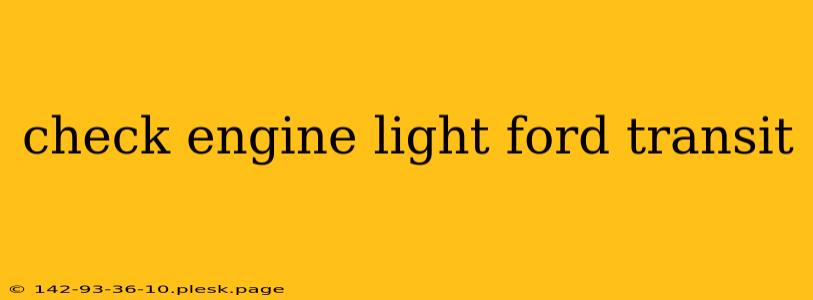The dreaded check engine light. Seeing it illuminate on your Ford Transit dashboard can be unsettling, sparking immediate concerns about potential repair costs and downtime. This comprehensive guide will help you understand the causes behind a check engine light in your Ford Transit, offer troubleshooting steps, and provide insights into potential solutions. We'll explore common issues, the importance of diagnostics, and when professional help is essential.
Understanding Your Ford Transit's Check Engine Light
The check engine light isn't just a random indicator; it's a signal from your vehicle's onboard diagnostic system (OBD-II). This system constantly monitors various engine and emission control components. When a problem is detected, the light illuminates, alerting you to a potential issue. Ignoring this warning can lead to more significant (and costly) problems down the road, potentially impacting performance, fuel economy, and even the longevity of your engine.
Common Causes of a Check Engine Light in Ford Transits
While numerous factors can trigger the check engine light, some are more common in Ford Transits than others. These include:
- Oxygen Sensor Issues: These sensors monitor the amount of oxygen in the exhaust and are crucial for proper fuel mixture. A faulty sensor can lead to poor fuel economy and increased emissions.
- Mass Airflow Sensor (MAF) Problems: The MAF sensor measures the amount of air entering the engine. A malfunctioning MAF sensor can cause rough idling, poor acceleration, and increased fuel consumption.
- Spark Plug or Ignition Coil Failure: Worn or faulty spark plugs and ignition coils can lead to misfires, resulting in a check engine light and potentially damaging the catalytic converter.
- Catalytic Converter Issues: A clogged or damaged catalytic converter restricts exhaust flow, impacting engine performance and triggering the check engine light.
- PCV Valve Problems: A faulty positive crankcase ventilation (PCV) valve can lead to excessive pressure buildup in the crankcase, affecting engine performance and causing oil leaks.
- Loose or Damaged Gas Cap: While seemingly minor, a loose or damaged gas cap can allow fuel vapors to escape, triggering the check engine light.
Troubleshooting Your Ford Transit's Check Engine Light
Before rushing to the mechanic, you can take some preliminary steps to potentially identify and resolve the issue:
1. Check the Obvious:
- Gas Cap: Ensure your gas cap is securely tightened. A simple fix can sometimes resolve the problem.
- Visual Inspection: Look for any visible damage to hoses, wires, or components under the hood.
2. Obtain Diagnostic Trouble Codes (DTCs):
- OBD-II Scanner: An OBD-II scanner, readily available at most auto parts stores, can read the diagnostic trouble codes stored in your vehicle's computer. These codes provide specific information about the detected problem.
3. Interpreting DTCs:
- Online Resources: Once you have the DTCs, utilize online resources or repair manuals specific to your Ford Transit model and year to understand the meaning of the codes and potential solutions.
When to Seek Professional Help
While some minor issues can be addressed with DIY solutions, it's crucial to seek professional help from a qualified mechanic in the following situations:
- Complex DTCs: If the DTCs point to complex engine or emission control system problems.
- Uncertain Repairs: If you're unsure about the repair process or lack the necessary tools and expertise.
- Persistent Problems: If the check engine light continues to illuminate after attempting troubleshooting steps.
Preventing Future Check Engine Light Issues
Regular maintenance is key to preventing future check engine light issues. This includes:
- Regular Oil Changes: Using the correct oil type and following the recommended oil change intervals.
- Spark Plug Replacement: Replacing spark plugs according to the manufacturer's recommendations.
- Air Filter Replacement: Regularly replacing the air filter to ensure proper airflow to the engine.
Addressing a check engine light promptly is essential for maintaining your Ford Transit's performance and longevity. By following these steps and understanding the potential causes, you can effectively troubleshoot and resolve the issue, keeping your vehicle running smoothly on the road. Remember to always consult your owner's manual and seek professional help when needed.

